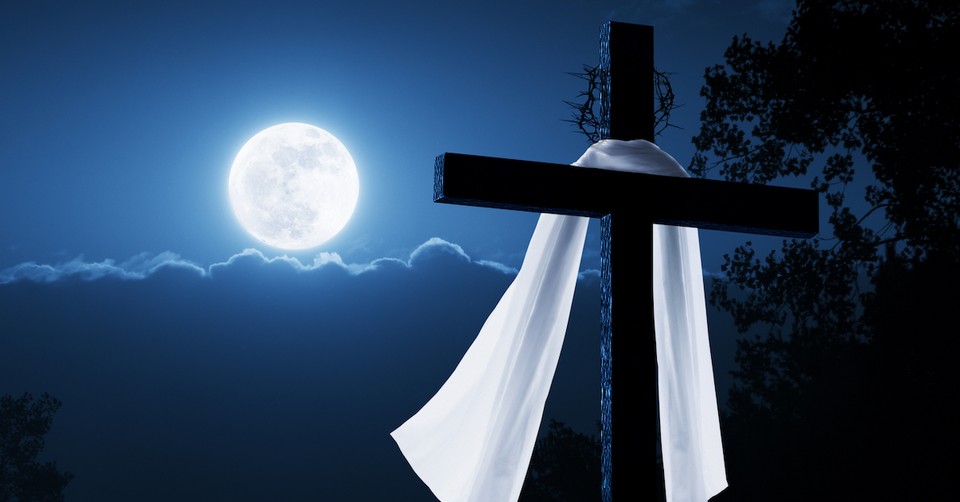The Easter Night Sky

Mel Gibson's stunning motion picture, "The Passion of the Christ," opens with a dramatic close-up view of the Full Moon. From there, we see Jesus and His disciples in the Garden of Gethsemane, and the subsequent events from the Gospels are shown set against the pale brightness of the Moon's light.
The Moon is shown several times in that opening scene, as if to impress upon the viewer that these events did indeed take place on the night of the Full Moon. In this astronomical way, as in so many other ways, the maker of this remarkable film accurately depicted Biblical truth.
After all, Jesus was indeed crucified on the day following the Passover. And we do know from Scripture that the Passover is to be celebrated during the Full Moon of the current season. This particular Full Moon is commonly called "The Easter Moon," or more properly, "The Paschal Moon" and occurs on March 31, 2024.
The Astronomy of Passover
The first Passover was celebrated by the Israelites in their last night in Egypt. The Israelites were instructed by the LORD to kill an unblemished lamb, and place its blood on their doorposts, so that the angel of death would "pass over" the house and not kill the firstborn of that family. In this way, the firstborn children of Egypt were killed, after which Moses led the children of Israel from slavery to freedom.
The LORD commanded that the feasts of the Passover and unleavened bread be celebrated by Israel forever. And the timing of the Passover celebration is given as follows:
In the fourteenth day of the first month at even, is the Lord's Passover. - Leviticus 23:5
In our culture, if we hear "the fourteenth day of the first month," we would think this to mean "January 14." Our modern, western culture still uses a variation of the old Roman calendar, originally established by Julius Caesar in around 45 B.C. Our calendar is strictly a solar calendar, timed around the annual cycle of the Sun through the seasons, and oriented so that the solstices and equinoxes fall on the same dates each year.
In our calendar, "months" are simply arbitrary units used to divide the solar year. So the dates within our months are just numbers, with no reference to the Moon or its phases. But the Hebrew calendar used by the ancient Israelites and the modern Jews today is a lunar calendar. And in this lunar calendar, the "months" represent complete cycles of the Moon's phases. In this way, each date of the month represents a certain phase of the Moon, so that the same phases will fall on the same date from month to month.
So when the LORD commanded Israel to celebrate Passover on the evening of the fourteenth day of the first month, it was understood that this day was two weeks after the New Moon, which is to say, the night of the Full Moon of the first month. The Passover is called pesech in Hebrew, and in the Greek of the New Testament, this word is rendered as "Pasch." For this reason, the Full Moon of Passover is called "The Paschal Moon." (Ironically, this point is flubbed in Cecil B. DeMille's film classic, "The Ten Commandments" with Charleton Heston. In the scene of the night of the first Passover, the "destroyer" was shown as smoke, flowing past the Moon in the night sky. The problem was, the movie showed a waning crescent Moon!!! This is actually quite a serious mistake, since Scripture is clear that the Passover occurs at the Full Moon. It is amazing that such a blunder could sneak into this classic movie, a multi-million dollar production that drew from the labors of numerous researchers and consultants, including prominent scholars and rabbis. It is perhaps more amazing that very few people today would notice such a detail, and even fewer would care. This illustrates the extent with which the most commonplace facts of astronomy are ignored and misunderstood in our high-tech world.)
The Full Moon
In our generation, very few people bother to notice the phases of the Moon. We might notice the Moon when outside in the evenings. But most of us never bother to observe the progression of the Moon's phase as we scurry around living our busy little lives. But even 100 years ago, most people lived close to the earth, and it was natural to follow the Moon's phases over the course of the month, increasing each night to the Full Moon, and decreasing in the weeks after. And this was certainly true in Biblical times.
For those of us who still follow the Moon's phases, we notice that the Full Moon rises in the east just as the Sun is setting in the west. The Full Moon crosses the sky all night, and reaches its highest point at midnight. The Full Moon finally sets in the morning, just as the Sun is coming up. So the Moon truly does "rule the night" as we read in Genesis 1:16. Here's an excellent classical description of the Full Moon:
"Now God commanded the Sun to measure the day, and the Moon, whenever she rounds her disc, to rule the night. For then these two luminaries are almost diametrically opposed; when the Sun rises, the Full Moon disappears from the horizon, to reappear in the East at the moment the Sun sets." - from the "Hexaemeron" of Basil the Great, Archbishop of Caesarea, circa A.D. 360.
On the night of the Full Moon, after it has risen high into the sky, it casts plenty of light! You can see very strong shadows under the Full Moon. Actually, the Full Moon is only one-millionth as bright as the Sun. But our eyes have been designed by the LORD to record a light level difference of one billion! So moonlight actually appears quite bright, since we can still see in light only 1/1000 of that level! This is still another manner in which our bodies are "fearfully and wonderfully made."
Moon Over Jerusalem
So the LORD in his provision had the children of Israel depart Egypt under the light of the Full Moon. We read in Exodus 12:29 that the LORD smote the Egyptians at midnight, and that that Pharaoh released the Israelites sometime afterwards. So the LORD gave His Chosen People plenty of bright moonlight for traveling as they left Egypt on foot.
From this night forward, God commanded that Israel celebrate the Passover on the evening of the Full Moon. So it only follows that Jesus and the disciples ate the Last Supper in the Upper Room as the Full Moon rose over Jerusalem. And in the night, the bright Full Moon shone down upon Jesus as He prayed in the Garden of Gethsemane, as depicted in "The Passion." This astronomical fact of Scripture is often overlooked. In fact, this also illustrates the extent of which the common astronomy of the Moon's phases is poorly understood in our generation.
We read in the Gospel accounts of the darkness that fell over the land during the crucifixion. Some rational-minded thinkers have attempted to explain this away as a Total Eclipse of the Sun that occurred during the crucifixion. However, such a solar eclipse can only occur during a New Moon, when the Moon is between the Earth and the Sun. However, the Paschal Full Moon occurs in exactly the opposite side of the sky as the New Moon, the completely wrong phase!
Also, a solar eclipse can only last as long as eight minutes, not the three hours of the darkness that happened during the crucifixion! So as we see, this miraculous darkness defeats any ill-informed attempts to at a rational, scientific explanation, again showing the folly of the "wisdom" of this world.
--------------------
This article is from the Classical Astronomy Update. Jay Ryan is also the author of "Signs & Seasons," an astronomy homeschool curriculum. For more information, visit his web site https://www.ClassicalAstronomy.com.
photo credit: Getty Images/iStock/ricardoreitmeyer
Originally published August 26, 2024.







